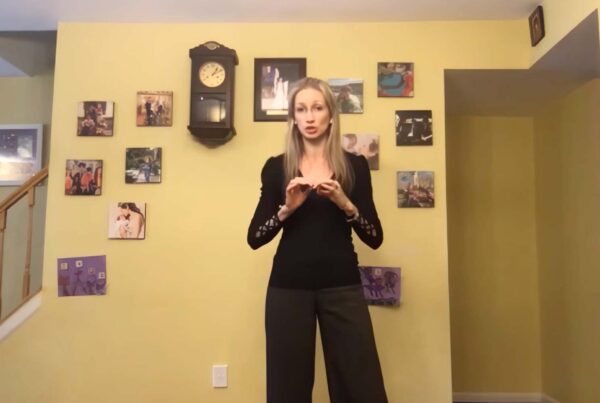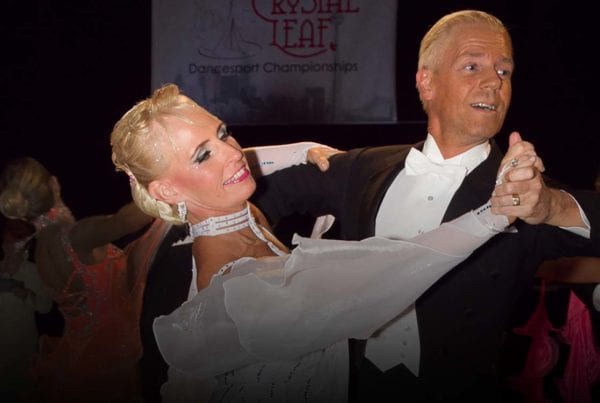It’s one of the most basic steps in the entire world of dance. The Natural Turn in Waltz. Yet, despite this familiarity — or perhaps because of it — this step is danced incorrectly by many dancers, including accomplished competitors. This article, intended primarily for intermediate-level dancers, gives you more insight into proper technique so that you can dance more beautifully.
In just three steps, the Waltz Natural Turn can immediately illustrate a person’s competence as a dancer. There are several areas of concern affecting both social dancers and competitive couples.
Rise and Fall
One of the most common errors we’re seeing is rising too early. Proper technique calls for the rise to begin at the “end” of beat one. Not on the one count but at the end of the count. For the person going forward, this means the right heel just begins to leave the floor at the end of beat number one. A great many dancers are already most of the way up on the foot on beat one, which significantly limits the amount of movement because there is no power left to apply to the remaining beats in the music. It also ruins the fluidity of the movement.
The person going backwards has to be grounded before swinging the free leg past and to the side, which calls for a “no foot rise” at the end of beat one. Because that person is on the inside of the turn, they should not have their heel off the ground too early. Instead, they generate upward energy through the body. One of the reasons for this action is to allow the person moving forward to actually get around the person going backwards, since the forward-moving partner has a greater distance to travel for the turn.
The couple should continue to rise not only on beat two but also into beat three. Far too many dancers are all the way up somewhere in the middle of beat two, just kind of holding their position in a static line as they wait for the musical counts to finish. This takes away from the beauty of the step. You must continue to rise on both beats number two AND three, although the rise slows.
The final part of the rise, on beat three, is largely the result of bringing the feet together. This final rising action can be emphasized by stretching your spine upward and away from your partner while generating matching vertical energy through the ribcage to counter-balance the spinal energy. This is simple physics, yet dancers who are not aware of it inadvertently minimize the chance to see that continual rise taking place.
Lowering only happens at the end of beat three. This lowering action is where the power begins for the next step. Again, so many couples tend to lower at the beginning or middle of beat three instead of the end of that beat. Typically when they do this the lowering process slows or stops as the heel touches the ground, which throws away energy. Since the lowering action is meant to create power for the next step, it is better to lower very late on beat three and then continue to lower after the heel touches the ground.
Even worse than lowering too early, some dancers are already thinking of the next step and move their bodies forward or back before they have generated any power with which to actually take that step.
CBM
Another common problem is failing to apply Contra Body Movement during the turn.
In a typical Natural Turn, each partner has to effectively make a 3/8 turn on every part of the step pattern. The person going forward divides the step into two parts. On the first part they turn one quarter to the right. As the feet close, the feet continue to turn slightly, completing the turn of the foot. While there’s some flexibility for championship-level dancers in the amount of turn due to their high energy levels and amount of body flight, this 1/4 plus 1/8 division is essential at syllabus levels and for social dancing. It may not be ridiculously hard to accomplish this when you go forward, but for the partner going back it becomes a nearly impossible task if you don’t rotate the bodies. Why? Because the partner going back has to point their foot 3/8 to the right! If your back is still turned to that end position, how could you possibly point the foot to a direction that is essentially backwards?
Accomplishing this turn can only happen when we rotate our centers slightly to the right as we turn, allowing the person going backwards to point the foot in the right direction and generally making everything more efficient. It’s called CBM, or Contra Body Movement. This is the action of moving the side of the body “contra” to the moving leg. In other words, when going forward we move the left side of the body forward as we also move the right foot forward. Moving backwards, the left foot goes back along with energy from the right side of the body. With the application of this CBM, the person going forward can now easily step to the side in a quarter turn, and the person going backwards can easily point their foot because that is no longer a backwards direction but with that slight body turn becomes a sideways direction for the foot.
I came across a great slow-motion video that illustrates some natural turn action from a few of the world’s top couples. Take a look and see how they apply the dividing of the forward steps and the pointing of the backwards steps. Watch also the excellent posture, the use of CBM and the way they use vertical energy through all three beats of the music, waiting to lower until the very end of the third beat.













